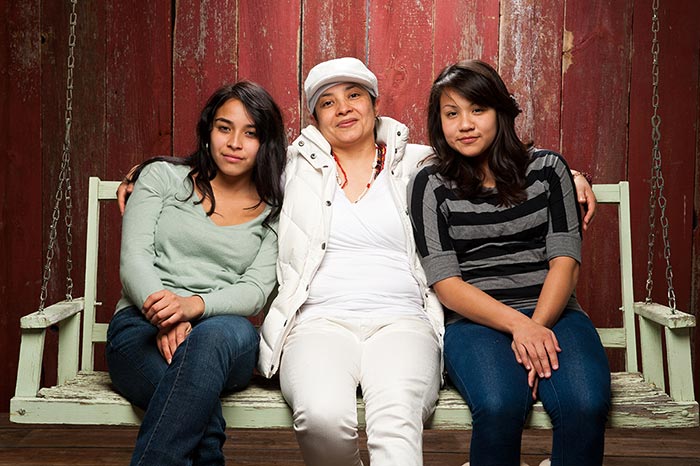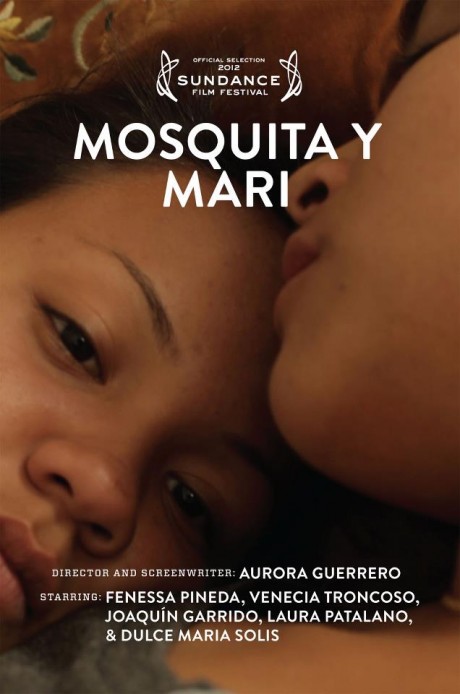In the independent film “Mosquita y Mari,” filmmaker Aurora Guerrero tells the story of two young Latinas (Fenessa Pineda and Venecia Troncoso) and the relationship they develop during their high school years. The film, which premiered at the Sundance Film Festival in January and was nominated for the John Cassavetes Award at the Independent Spirit Awards, is currently available on DVD.
What was the inspiration behind a story like “Mosquita y Mari?” Why did you want portray this relationship in a film?
Originally when I started writing this, I didn’t know it was going to be my first feature. I was in grad school and I was in a class that was very loose in structure. We didn’t have to turn anything in. We didn’t have to write screenplays. We just had to write and write from a place familiar to us in our lives. I started to write about my experiences with this young woman growing up. I found myself almost connected and obsessed with writing about this. It largely had to do with the fact that I had never talked about it. It was something that happened in my life that was very internal and something that happened between me and this young woman, but we never talked about it. I had this suppressed major experience of falling in love for the first time but I had never given it a proper place in my life until I started writing about it.
Was writing this story liberating for you?
Yes, because I felt l was breaking this huge silence. I was already identifying as queer by the time I was in film school, but I had never gone back and looked at where that started to happen in my life. It was through this friendship/first love that I really started to come into that identity without putting any labels to it. So, it was a very personal piece. It was refreshing for me in many ways because I felt like it was haunting me. Then I decided to turn it into a screenplay and make it my first feature because I knew that making a feature film was a long road. It made sense to do something I was passionate about to get me through that long journey. The passion was not only because it was me bringing voice to this experience, but it was also because I really felt there was a gap in stories about young brown love.

Even more so, young brown queer love.
Right. Straight or not, we hardly ever see a love story between young Latinos. The only film I felt was doing that in a contemporary way was a film called “Don’t Let Me Drown.” We need our love stories out there. This is as much anyone else’s love story as it is my love story. I feel we have had these awkward, nervous, exciting , giddy crushes or first loves at that age. I felt a lot of people would be able to identify with that feeling regardless of gender. I felt that was an important part of making this film. It’s time to tell these stories and tell them in a very modern way.
The two movies that came to mind as I was watching your film were “Don’t Let Me Drown” and “Raising Victor Vargas,” so I definitely see what you mean when you say there are not many films out there that portray love from a young Latino’s perspective. At the same time, Latinos are the biggest movie-going demographic but they, a lot of the times, don’t go out and support their own movies. Do you see a way to fix that?
It’s complicated. When I think of the Latino community, I think of the working class Latino community. I think our community hasn’t had access to independent films historically. There aren’t art-house theaters in our communities. They usually lie in hipster, white communities. They are also inundated with big blockbuster, mainstream billboards and ads and theater chains that keep them away from independent films. There’s a need to cultivate audiences in our community. There’s almost this level of training that has to come with watching independent films. It’s not your contrived traditional storytelling structure. Like mine, it’s more lyrical. It’s not heavily plot driven. The Latino community is used to a certain formula and structure that doesn’t really provoke any thinking. When they watch films like this, sometimes it can be challenging as an audience because they’re used to films like “The Fast and the Furious.”

Speaking of “The Fast and the Furious,” actress Michelle Rodriguez, who has starred in a few of those films, started her career with the independent film “Girlfight” in 2000 but then started to get popular and kind of abandoned that part of the industry for the blockbuster-type movies. I don’t blame her. I mean, I’m sure it’s extremely difficult for young Latinas to find a lot of roles that don’t portray them in a stereotypical way.
I think in Michelle Rodriguez’s case she is talented, so Hollywood comes and swoops her up. I don’t think they swoop her up for her talent though. I think many times they swoop her up for movies where she is objectified as a sex symbol. That’s often where she lands. She is used for her beauty and not her talents. That is unfortunate for us as filmmakers who lose her to that.
Well, you found two incredible talents yourself for the lead roles in “Mosquita y Mari” in Fenessa Pineda and Venecia Troncoso. What were you l looking for when you started casting these parts?
I was looking for two young women who identify with the community. I was hoping to find someone who was from southeast L.A. that identified as Chicana, bilingual and bicultural. That was very important for me. Those were the parameters that I had set for myself and the casting director. That led us to weed out a lot of young women. We had two initiatives in the casting. One was a community-driven initiative and the other was a traditional call out to managers and agents. What I was finding on the community end when I was in high schools was that the majority of them were bilingual and bicultural and very representative of that area and very much identified with their immigrant heritage, but they were non-actors. I was looking for young girls that had a natural ability. I found the community initiative weeded out a lot of girls. I was able to cast a couple of characters from that initiative, but I was not finding Mosquita or Mari. These two characters carry this film on their backs. It is a very internal film. The traditional casting and the young women who were coming through that, the majority of them, had some training and had a good sense of carrying a scene, but they weren’t bilingual. They were second generation Latinas and a little detached from their communities. I couldn’t compromise that. I needed both. I was very adamant about it. So, we just kept looking and looking. Both Fenessa and Venecia came to me through the traditional casting call. Not only were they incredibly gifted young actors, but they also were both bilingual and bicultural. Those were the elements I was looking for. When I brought them together they definitely had a really beautiful connection from the very beginning. They didn’t know each other yet they felt very comfortable with each other. There was this flirtatiousness between them. I don’t even know if they were conscious of it, but it was just there. It was really beautiful to observe. I fell in love with them right away.
Going forward now, what challenges do you see as a Latina filmmaker? I bring this up because I know you’ve worked with director Patricia Cardoso before. She made the wonderful film “Real Women Have Curves” back in 2002 and we haven’t heard from her since. She’s just one example, but I’m wondering if that worries you as a Latina filmmaker that even though your first feature is successful and critically acclaimed and premieres at Sundance, it’s still going to be difficult to find your place in this cutthroat industry.
It’s unfortunate that happens to women filmmakers trying to make their second film. I observed that with Patricia. I think in her case, when “Real Women Have Curves” was in post-production, she found out she was pregnant. It was something she wanted for a very long time. She was very blessed. She took a couple years off to be with her child during those instrumental years. When she came back to the industry, she found that she faced a lot of judgment and discrimination because of that. During that time when her film had so much momentum and her name was really hot and out there she was at home being a mom. Patricia is very talented and should be making films. It’s heartbreaking for me to see that she’s not. I am very well aware of the challenges for me. I can’t say I know exactly what that will look like, but I am conscious of it. I just know I can’t sit back and be comfortable and think it’s all going to just come to me and that I’ll be showered with all these opportunities and that I’ll be able to make films for the rest of my life. You don’t know where the resources are going to come from, but you just have to keep pushing and trying. In my case I feel this is my life calling. I’m going to do everything I can to be able to tell the stories I want to tell.